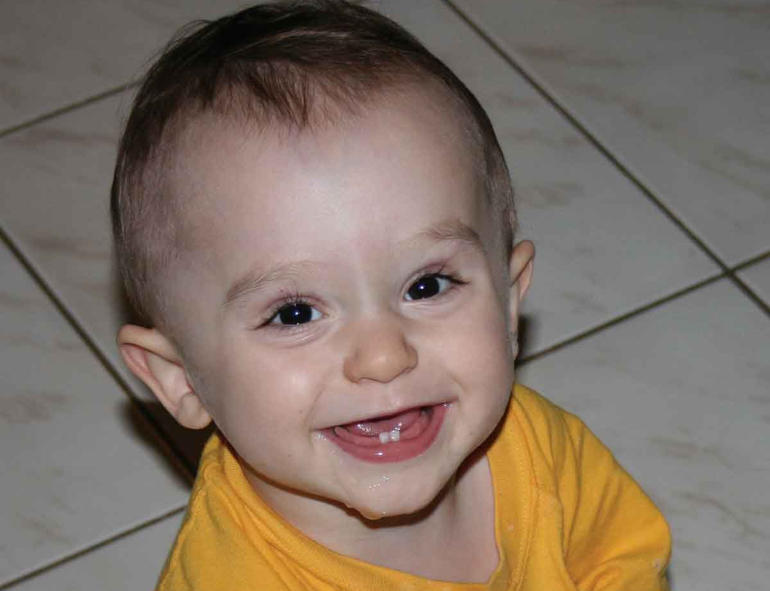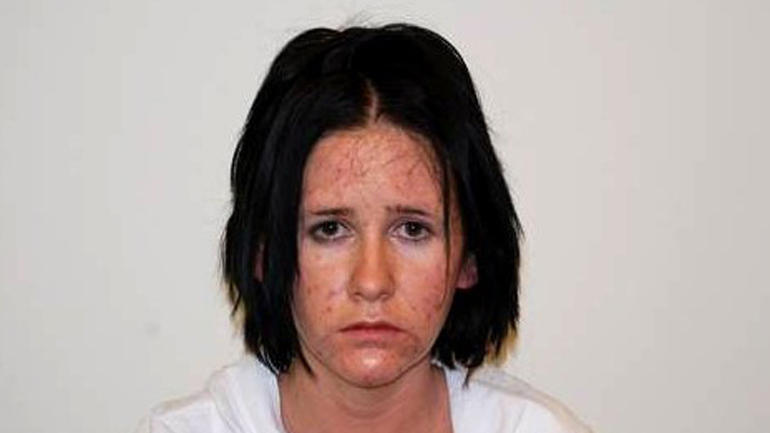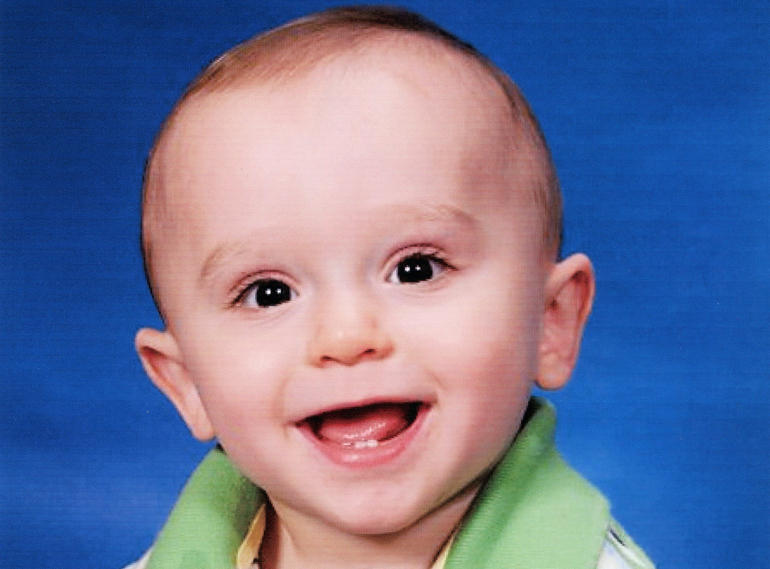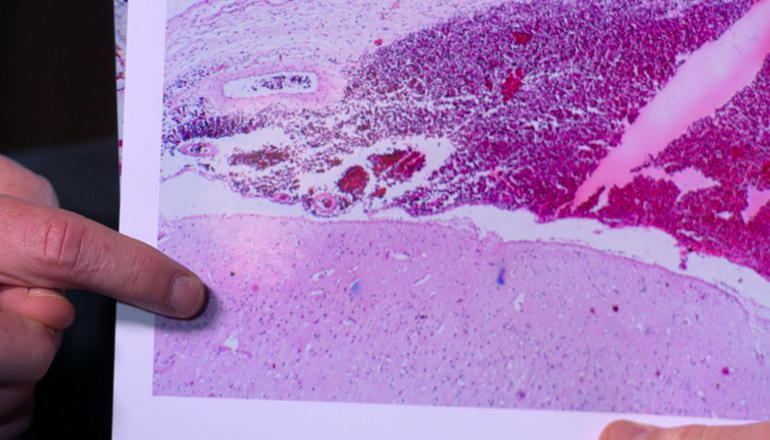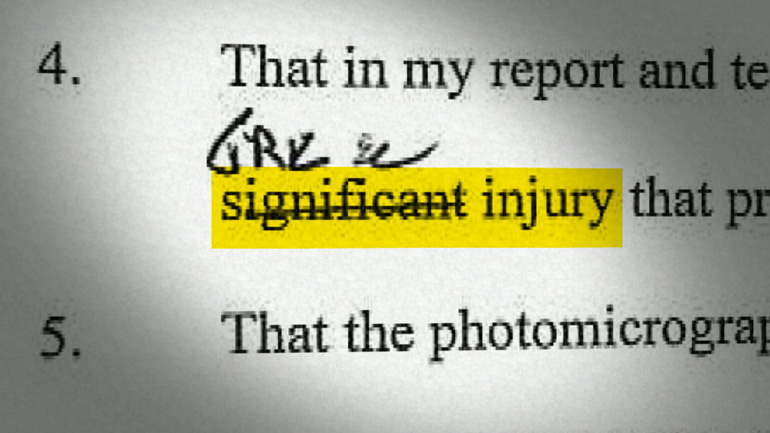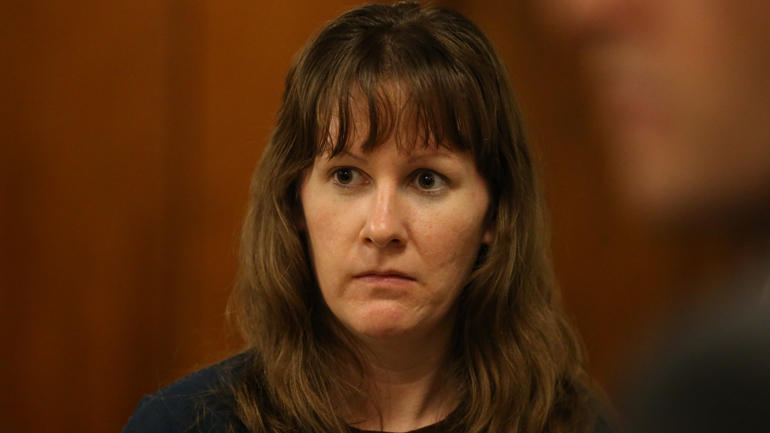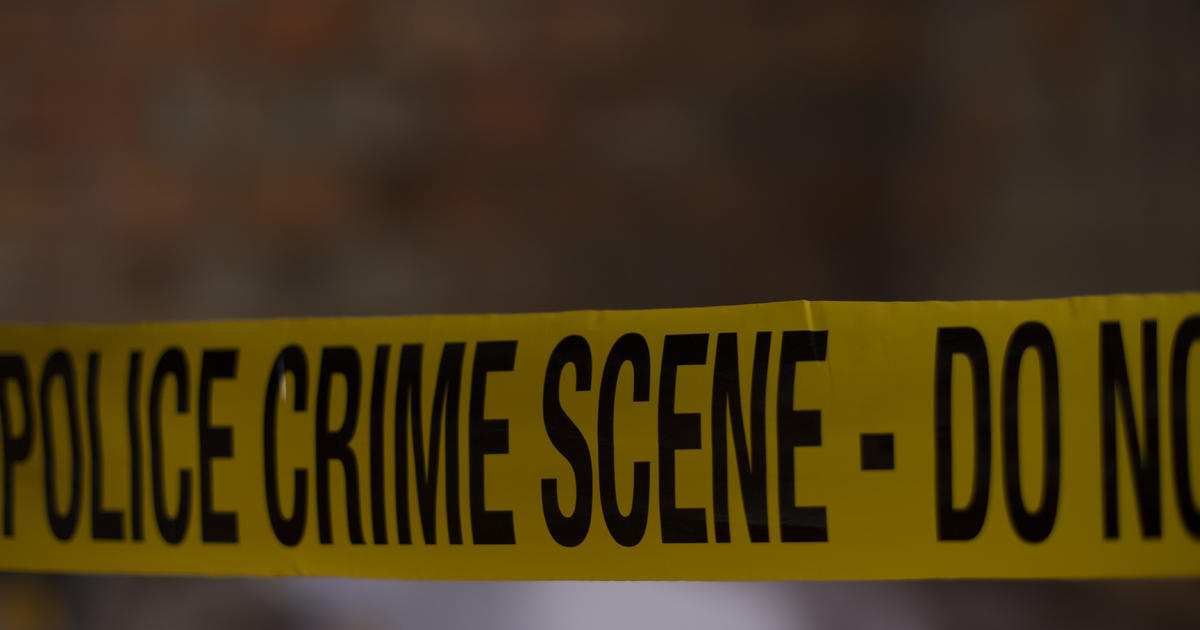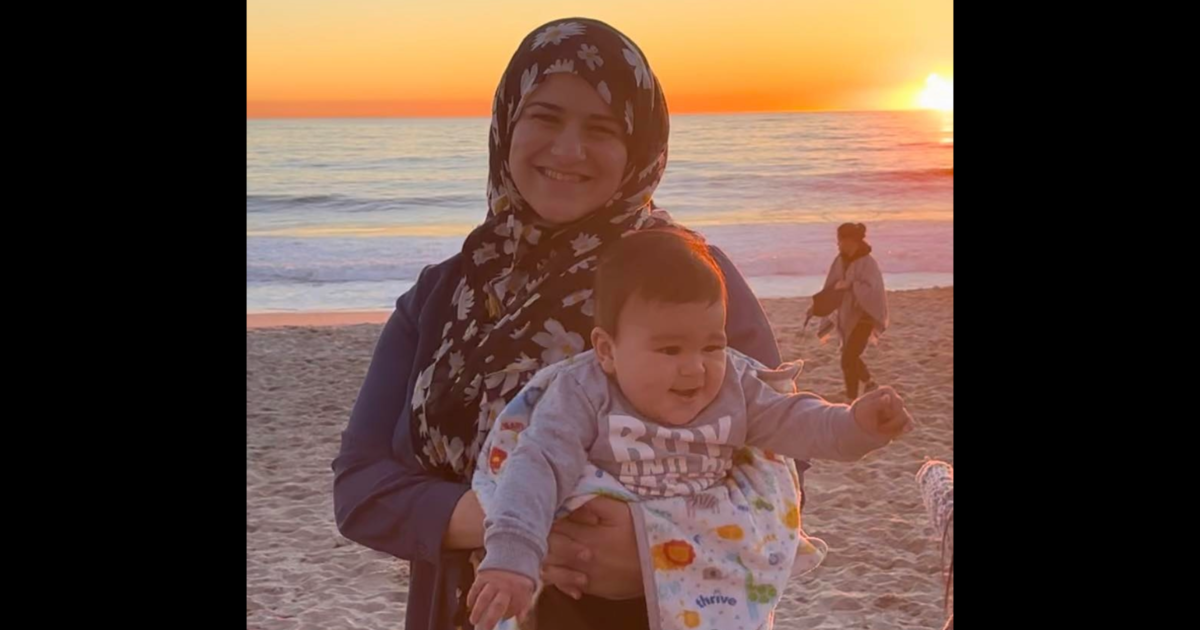The Fight for Melissa
Produced by Lourdes Aguiar, Gail Abbott Zimmerman and Charlotte Fuller
Every day, Melissa Calusinski wakes up in an Illinois prison -- a convicted child killer.
“I had nothing to do with it and I’m going to keep continuing to say that,” she said. “…because I had nothing to do with Ben’s death.”
In January 2009, 16-month-old Benjamin Kingan died after being in day care. Melissa, the last person to care for him, was found guilty of his murder two years later.
“Everybody knows that the conviction’s rotten to the core,” said Kathleen Zellner, an attorney
who has built a career out of getting the wrongfully convicted out of prison. She tackles high-profile cases like Steven Avery’s from “Making a Murderer” fame.
Zellner is convinced Melissa didn’t get a fair trial.
Melissa is now at the center of a media and legal storm in Lake County, Illinois. There are allegations of medical errors, evidence tampering and even perjury.
Before Melissa became a cause celeb, she was living a quiet life with her parents in a working class neighborhood outside Chicago. “48 Hours” first interviewed her in 2014.
“My family was wonderful. I’m the youngest of five altogether,” she told “48 Hours” correspondent Erin Moriarty.
Paul and Cheryl Calusinski are Melissa’s parents.
“She’s a kind hearted person,” Cheryl Calusinski said. “She would bend over backwards for anybody.”
Growing up, Melissa never got in any trouble, yet she stood out in other ways. She sometimes had trouble expressing herself and understanding others. Melissa’s sister, Crystal, says she was teased at school.
“What would kids say?” Moriarty asked.
“Just mean things, like …’You don’t know this. You’re stupid,’” said Crystal.
“She would come home crying sometimes off the bus. Kids would tease her,” said Paul Calusinski.
But as she got older, Melissa found her calling.
“She wanted to be taking care of children,” said Cheryl.
So when an opportunity later came up to work at the Minee Subee day care center with Crystal, Melissa, then 22, jumped at the chance to be a teacher’s assistant.
“You know, just hearing them ... little babies it makes my day. It makes my day just being around them,” she said.
One of the children in Melissa’s care was toddler Benjamin Kingan. Ben, his twin sister, and two older siblings all attended the day care center in Lincolnshire, an affluent Chicago suburb.
January 14, 2009, started out as a typical day.
“I came to work on Wednesday. And I saw Ben. He was fine, normal, happy, playful,” Melissa recalled.
Around 3:30 p.m., after the kids were fed a snack and cleaned up. Melissa says she put Ben down on the carpet and he crawled into his bouncy seat on the floor.
“He was sitting in his bouncy chair playing with his blanket,” she explained. “And he started to fall back asleep which was normal.”
A teacher who was in the room stepped out briefly, leaving Melissa alone with the children. Melissa says that’s when she noticed something wrong with Ben.
“He didn’t look right. …I took his little hand and I touched his hand and I’m like, ‘Ben, Ben.’ He did not wake up at all,” she explained.
“I saw orange foam ... coming out of his nose, and -- um I’m sorry,” Melissa said in tears.
Melissa called for help and Crystal rushed in and administered CPR. Ben was taken to the hospital, but he was pronounced dead an hour later.
“Me and my sister fell to the floor, and we’re just -- we’re just bawling,” said Melissa.
“What happened to him and how? I don’t understand,” she continued.
Ben’s death was a mystery. He did not have any cuts or obvious wounds; no serious bruises. But pathologist Eupil Choi would come up with an answer after two autopsies: Ben Kingan died from blunt force trauma of the head.
Dr. Choi said that Ben had suffered a skull fracture and massive brain hemorrhaging that happened that day. So investigators brought in the caregivers who had been with the toddler.
Cop to Crystal Calusinski: Somebody did something to him.
Crystal Calusinski was questioned for eight hours and eventually released. But Melissa remained with police.
“What did they tell you had happened to Ben?” Moriarty asked.
“That he died of a skull fracture,” Melissa replied.
Det. George Filenko | Lake Zurich Police Department: All you need to tell us is the truth.
Det. George Filenko: You know 100 percent. We know what happened, but we need you to tell us. Tell us what happened.
Investigators read Melissa her rights, and then over and over -- at least 79 times -- she denied doing anything to Ben.
Melissa Calusinski: I never put my hands on him … I did not drop him. …I completely did not do it.
“And I kept continuously repeating myself,” she said.
Det. Sean Curran | Lake Zurich Police Department: Please don’t make us drag everything out of you because it makes it seem like you are being deceitful to us.
“And they were just continuously not believing me,” Melissa told Moriarty.
But after nine hours in that room -- under pressure and without an attorney -- Melissa confessed.
Det. Sean Curran: He starts acting up and you get mad at him and you throw him on the floor.
Melissa Calusinski: [Nods to affirm]
Det. George Filenko: You threw him on the floor?
Melissa Calusinski: Yeah. Really hard.
Det. George Filenko: Really hard?
Melissa Calusinski: Yeah.
She is taken to another station for booking and repeats the same story to another investigator.
Officer Adam Hyde| Lincolnshire Police Department: How hard did you throw him?
Melissa Calusinski: I went like that (throws doll down hard)
After spending 14 hours with police, Melissa was arrested for the murder of Benjamin Kingan -- even though she almost immediately recanted her story.
Melissa Calusinski [in police car]: No, I’m innocent.
“The picture they put of Melissa on the news … she just looked horrible,” Deluca said. “The initial reaction from everybody is this horrible person did this unspeakable act.”
Attorney Paul Deluca knew he was facing a difficult battle from the moment he took on Melissa’s case.
“It’s such an emotional case… see, what happens is a jury is going to want to find someone accountable,” he said.
But as Deluca prepared for the upcoming trial, he became convinced that the medical evidence was wrong and that Melissa had given a false confession.
“I had full confidence that I was gonna beat it because I knew I’m innocent,” said Melissa.
THE THEORIES
The State’s theory was that Ben Kingan was a perfectly healthy 16-month-old when he died on Jan. 14, 2009. Lake County Assistant State’s Attorneys Stephen Scheller and Matt DeMartini were part of the prosecution team.
“He was a very … healthy baby,” Scheller said. “Just a happy, happy little boy.”
“How would you describe what the parents have gone through?” Moriarty asked.
“When somebody takes your child from you, I don’t think there’s any words to describe what they’ve gone through,” said DeMartini.
Melissa’s trial began in November 2011. Prosecutors presented what they said was indisputable medical evidence. According to pathologist Dr. Choi, Ben suffered a skull fracture and massive brain bleeding on the day he died.
“There’s a massive, massive catastrophic injury to this child,” said Scheller.
But the defense believed Ben had an old injury that contributed to his death. The injury was discovered at day care before Melissa started working there. A teacher, Nancy Kallinger, told investigators she heard a noise while another worker was handling Ben.
Nancy Kallinger to investigators: I had my back turned to her… I heard a thump, like, he hit, you know, the bars on the crib.
Kallinger said Ben later woke up with an obvious injury:
Nancy Kallinger: He got a bump on the back of his head … I mean we called the mom. The mom called the doctor.
But Prosecutor Stephen Scheller says that the injury in October 2008 was minor.
“The pediatrician actually examined Benjamin’s head, had felt around, said there were no issues that she felt needed to be addressed, that mom should just keep an eye on him,” Scheller explained. “Ben never had an issue after that.”
Not according to defense experts. They say that after that day, there were possible signs of head trauma. Medical records showed that Ben was lethargic. And Nancy Kallinger had pointed out to investigators that Ben slept a lot:
Nancy Kallinger: There’s always something up with him. That he sporadically falls asleep.
And just two days before he died, Ben threw up on Melissa.
“This was big vomit. He -- it was like nonstop,” Melissa told Moriarty.
Prosecutor Matt DeMartini says Ben’s vomiting two days before his death was just a stomach bug or a winter cold.
“He was given Pedialyte and put to bed. He woke up the next day and he was fine,” said DeMartini.
But the defense says Ben’s prior injury was so serious that any new impact could have major consequences, and Ben did have a habit of throwing his head back.
“He would sit Indian-style, and when he got angry … he’d flip himself back and he’d hit his head. And he would do this over and over,” Deluca explained.
Nancy Kallinger recalled that Ben had done this twice shortly before his death.
Nancy Kallinger: I put him on the floor and he immediately threw himself on the floor … and I walked towards the sink and he threw himself again.
But prosecutors rejected the defense theory.
“This child did not explode or implode on his own,” said Scheller.
The State maintains that Ben died only from injuries caused by Melissa, who was overwhelmed by crying babies that day.
Melissa Calusinski: It’s frustrating with all these kids, cause they’re screaming, crying…
“She became frustrated holding Ben,” Scheller said. “She threw him to the floor.”
And Melissa even said there was a witness. She said Nancy Kallinger was at the sink with her back to them. Yet the teacher told police she didn’t hear anything.
Cop: She picked him up like this, raised up, and slammed him to the ground.
Cop: …those are her words, OK?
Nancy Kallinger: She wouldn’t have done that.
But Melissa said she did:
Det. George Filenko: You threw him on the floor?
Melissa Calusinski: Yeah.
Prosecutors told the jury that the blow was so severe it caused a skull fracture. They mentioned the skull fracture more than 30 times. Defense attorney Paul Deluca had little to counter it….these are copies of the X-rays he was given by the State.
“When I opened these X-rays, my thought is, ‘This is ridiculous. We have black X-ray[s].’ I’m laughin’ to myself. I can’t believe this.”
The last State witness at trial was pathologist Dr. Manny Montez. He told the jury in powerful testimony that he had examined the child’s body himself and had felt the fracture with his own hands.
“He said he put his finger actually through the hole. He said he could see through it,” Deluca said. “He kept saying, ‘this is a violent, traumatic forceful injury.’”
“How damaging was that?” Moriarty asked.
“It was terrible,” Deluca replied. “It killed us.”
Melissa Calusinski was found guilty of first-degree murder and sentenced to 31 years.
“I just … I almost lost it,” she told Moriarty of the verdict.
Melissa has long insisted she’s innocent, but jurors heard her admit her guilt in her videotaped interrogation:
Melissa Calusinski: And I went “boom!”
So why would Melissa confess to a crime she says she didn’t commit?
“It took me years to wrap my head around the idea that somebody, short of having a gun to their head, would ever confess to a crime they didn’t commit,” Dr. Saul Kassin, a professor at John Jay College, told Moriarty. “And yet, when you look at the database of known wrongful convictions … Homicide cases in particular, where there is DNA to exonerate … 60 percent of them contain false confessions in evidence.”
Doctor Kassin has testified about false confessions in numerous cases, but the judge wouldn’t allow any false confession testimony at Melissa’s trial. “48 Hours” asked Dr. Kassin, a CBS News consultant, to analyze Melissa’s interrogation.
“I don’t look at a case like this and pretend to know whether she did something or not,” he explained. “But I have concerns … she’s a vulnerable suspect.”
When the defense had Melissa’s mental capacity tested, she showed “extreme vulnerability to suggestion” and scored at the bottom for verbal comprehension.
Melissa Calusinski: …because I’m trying to think, what did I do...
And Dr. Kassin says Melissa’s long interrogation is worrisome.
Melissa Calusinski: I had nothing to do with it.
“The average length of an interrogation … is 30 minutes to two hours. This one goes nine hours,” he explained. “It’s clear that long interrogations put innocent people at risk.”
“Everybody has a breaking point,” Dr. Kassin continued.
Melissa Calusinski: I never put my hands on him.
Hour after hour Melissa denied she hurt Benjamin:
Melissa Calusinski: I did not drop him.
Yet, the investigators ignored her denials. And that’s not all. When they asked her to take a lie detector test, “She immediately says, ‘yes.’ Not a problem,” said Dr. Kassin.
Det. Sean Curran: …It’s called a polygraph examination.
Melissa Calusinski: OK.
Det. Sean Curran: Is that something that you’d be willing to take after this?
Melissa Calusinski: Yeah.
“Professionally-trained interrogators are led to understand that the innocent person who has nothing to fear and nothing to hide is more likely to say yes,” Dr. Kassin explained. “Then they ask, ‘You know, there are kids in the room who may be able to communicate…’”
Det. Sean Curran: We have a specialist who speaks with children … do you think it would be a good idea to have that specialist talk to the children that were in that room?
Melissa Calusinski: Yes, I agree.
“If she has something to hide, she might go, ‘Uh oh. Really?’ She says, ‘Yeah. I think that’s a good idea,’” Kassin said. “…she acted just like an innocent person should act … They overlook the innocence cues.”
“And I would argue that after hours and hours of-- of denials,” said Dr. Kassin.
Melissa Calusinski: I didn’t do anything!
“…in each case, the denial is met with a punishing rejection,” Dr. Kassin pointed out.
Det. Sean Curran: Give me a f---ing break, this kid’s dead.
“She figures out what she needs to do,” said Dr. Kassin.
Det. George Filenko: We’re not going anywhere until we get the facts here.
“I was just ready to get away from these men,” Melissa told Moriarty.
“And the script is clear,” Dr. Kassin said.
Det. Sean Curran: I do think an accident happened.
“Sixty-eight times the word accident … or mistake or mistaken is made by the detectives to describe what likely happened here,” he continued.
“And, in fact, it comes from them first?” Moriarty asked.
“Absolutely comes from them first, the idea that this is an accident,” Dr. Kassin replied,
Det. Sean Curran: Did you hit his head by accident with something?
Melissa Calusinski: Nope.
Det. George Filenko: …we’re not here to condemn you, we’re not here to put you in jail…
After nearly six hours with investigators, Melissa tells them it was an accident.
Melissa Calusinski: ‘Cause I didn’t fully put him down, and he kind of almost slipped when I dropped him. And he hit the chair.
But investigators don’t accept her answer. They were convinced someone had deliberately hurt Ben that terrible day.”
Det. Sean Curran: There’s no way that that would have cracked his skull.
Det. George Filenko: I’m not believing anything you’re telling me right now.
“A couple hours later … the tone is changing. And now the accident is more of a premeditated act,” Dr. Kassin explained. “Suddenly the word ‘frustrated’ and ‘angry’ makes its appearance.”
Det. Sean Curran: He didn’t do anything to frustrate you? Was this something out of frustration?
Melissa Calusinski: [Shakes her head no)
Det. George Filenko: Something frustrated you, something happened…
After nine hours in that room, Melissa finally breaks.
“They’ve made it clear that there’s only one way out,” said Dr. Kassin.
Investigators give Melissa a scenario of what she did and why she did it:
Det. Sean Curran: We think in this situation the other babies are screaming, crying, whatever ... he starts acting up, and you get mad at him and you throw him on the floor.
Melissa Calusinski: [Nods to affirm]
…and she goes along with it.
Det. George Filenko: You threw him on the floor?
Melissa Calusinski: Yeah. ... really hard.
Det. George Filenko: Really hard?
Melissa Calusinski: Yeah.
Melissa told “48 Hours” she truly believed that if she told investigators what they wanted to hear, they would all just go home.
Melissa Calusinski: ...I’m just kind of curious, how long … much more, ‘cause ...?
Det. George Filenko: Not much longer, we’re on the phone right now. We’re trying to get this done as quickly as possible.
Melissa Calusinski: OK. Because I just want to go home and spend time with my parents and my puppy.
Melissa Calusinski: Now is this going … to be going on my record?
Incredulous, Dr. Kassin remarked, “Is this gonna go on your record? Do you have any idea what’s happening to you right now?”
Dr. Kassin says the detectives coached Melissa to tell a story that matched the medical evidence. But what happens if the medical evidence was wrong?
“Normally a pathologist is not 100 percent. But I feel she’s 100 percent innocent,” said Dr. Thomas Rudd.
A SECOND LOOK
In 2012, Melissa Calusinski had spent a year in prison when her father persuaded Dr. Thomas Rudd, the newly elected Lake County Coroner, to review the autopsy evidence that had helped convict her.
“And I was stunned. I could not believe what I was seeing, because it was the exact opposite of what was written,” Dr. Rudd told Moriarty.
At Melissa’s trial, pathologist Dr. Choi told the jury that Ben Kingan did not have an old injury. But according to Dr. Rudd, Dr. Choi had made a glaring error.
“I saw a membrane, and I thought, ‘my God,’” said Rudd.
“This is a slide of a part of this infant’s brain?” Moriarty asked.
“Correct … This is a membrane, this is a scar tissue, this is a scab,” Rudd told Moriarty, referring to the slide. “By definition if you have a membrane you have an old injury.”
Doctor Rudd was so flabbergasted that he called in Dr. Nancy Jones, a well-regarded pathologist who has performed more than 10,000 autopsies. She too saw evidence of an old injury -- one that had been healing for about two or three months, a time frame consistent with that bump the day care workers noticed on Ben’s head.
“How big was that old injury?” Moriarty asked Rudd.
“Four inch-by- four inch,” he replied.
“Isn’t that significant?” Moriarty commented.
“Hugely significant. And how they let that go is beyond me,” Rudd replied.
Doctors Jones and Rudd believed this old injury was further exacerbated by Ben’s head banging, and point to evidence of brain swelling.
“His head circumference was large,” said Dr. Rudd.
For the first year of his life, the size of Ben’s head, the circumference, was consistently around the 50th percentile compared to other children his age. But less than two months after the October injury, Ben’s head circumference increased to the 75th percentile. At the time of his death, a few short weeks later, Ben’s head measured in the 95th percentile.
“That is drastic. There’s something wrong,” said Dr. Rudd.
Doctors Rudd and Jones acknowledge that Ben did suffer another injury on the day he died, but it may have been a minor bump on the floor that caused that final, fatal swelling of the brain.
“The added fluid of the recent injury … pushes that brain down and shuts down the breathing system. This was the cause of the child’s death. It was the old injury. The old injury was massive,” said Dr. Rudd.
Dr. Rudd knew he had to do something so he called the now retired Dr. Choi.
Asked if he was nervous about it, Rudd told Moriarty, “Yes ... I thought for a very long time, ‘How will I do this?’”
To Rudd’s relief, Dr. Choi admitted he was wrong. He even signed a sworn affidavit conceding that, “in my report and testimony I missed that Ben had suffered an old injury.”
But he crossed out the word “significant.” Prosecutors Matthew DeMartini and Stephen Scheller say it doesn’t change the case at all.
“There’s no indication anything there is significant,” said DeMartini.
And their boss, Lake County State’s Attorney Michael Nerheim, points to a document in which Dr. Choi was asked whether the finding of the old injury would have changed his testimony at trial and he said “no.”
“If his mistake changed the ultimate -- his ultimate opinion, which he hasn’t said that he did, that would concern me,” said Nerheim.
But Dr. Rudd suspected that Dr. Choi may also have been wrong about another major part of the State’s case -- that alleged skull fracture.
“The alleged fracture was right in the middle of the head and towards the right going one inch,” Dr. Rudd explained, pointing to the spot on top of his own head.
“And there’s no laceration there? There’s no bruise?” Moriarty asked.
“None. None whatsoever,” he replied. “How do you fracture a skull without causing tissue damage to the skin above it? It’s not possible.”
Dr. Rudd believes that what Dr. Choi may have actually seen was just a normal part of Ben’s growing skull, but he couldn’t prove it.
But in June 2015, that would suddenly change. Melissa’s father said he received an
anonymous call that there was a set of X-rays at the coroner’s office that was never given to the defense. When Dr. Rudd’s staff searched the computer archives, they turned up startling images.
“What was your reaction when you first saw these?” Moriarty asked Rudd of the X-rays.
“I was dumbfounded,” he replied.
According to Dr. Rudd, the X-rays are proof that Ben Kingan did not suffer a skull fracture.
“There’s definitely no skull fracture here. I’ve shown this to various pathologists and a radiologist,” Rudd explained. “They’ve all called me and said ‘there is no skull fracture in this child at all.’”
What the X-rays did confirm, says Dr. Rudd, was that Ben’s head was abnormally shaped which was a clear indication of brain swelling.
“His head looks like the old-fashioned light bulb.” he explained. “This is not a normal-shaped skull of a 16-month-old child.”
In 2015, Dr. Rudd reclassified Ben Kingan’s death from “homicide” to “undetermined.” Ben’s death may not have been a murder at all.
“It shocks me because if that would be the case, why am I still locked up?” Melissa told Moriarty.
Attorney Kathleen Zellner says the clear set of X-rays changes everything for Melissa, and in June 2015, filed a petition asking the trial judge to throw out Melissa’s conviction.
“This case screams that it was a wrongful conviction,” said Zellner.
Zellner contends that not only does she have new evidence that could have affected the outcome of the trial, but she charges that the X-rays given to the defense were manipulated and she says she can prove it.
A NEW HOPE
“That was her high school and this is…my God she’s a grown woman now. She’s grown up in jail,” said Paul Calusinski while looking at pictures.
Paul and Cheryl Calusinski have had one goal since the day their daughter Melissa was arrested in 2009: to bring her home.
“She knows that we’re doing everything we can,” said Cheryl.
“We do believe she will be coming home soon ... it’s just a matter of time,” said Paul.
aul tbd sound 30- years uff on table... “lusinski home and cut to them inside looking at letters...
Although two higher courts have upheld Melissa’s conviction, they are pinning their hopes on Kathleen Zellner. She’s pushing for an evidentiary hearing to present what she believes is new evidence before Judge Daniel Shanes -- the same judge who had presided over Melissa’s trial.
“Evidentiary hearings are extremely rare,” Zellner explained. “…you have to show there’s a substantial likelihood that there’s a constitutional violation.”
And Zellner says it will be especially difficult in Lake County -- a jurisdiction that has come under intense scrutiny in recent years for wrongful convictions.
“They do not want to admit error, and they’ve got a half dozen examples that have cost them millions and millions of dollars,” said Zellner.
The legal wrangling over the hearing would drag out for months -- the State insisting there’s no new evidence. By then, Matt DeMartini had left the State’s Attorney’s Office for private practice.
Melissa’s family and supporters waited for word on a decision.
“The wheels of justice are moving slow,” Paul Calusinski told supporters outside the court.
In June, Judge Shanes finally agreed to grant Melissa her day in court. The Calusinskis were overwhelmed.
“I was just ecstatic. Started crying, actually,” said Melissa.
“Did you think this day wouldn’t come?” Moriarty asked.
“I knew it was gonna come, but I wasn’t expecting it to hit me as hard as it did that day,” she replied.
In August 2016, five years after she was convicted of murdering Benjamin Kingan, Melissa Calusinski was back in a courtroom for a hearing that could decide if she goes free.
“How much is riding on this?” Moriarty asked Zellner of the hearing.
“Everything,” she replied.
“I hope that the judge sees the evidence that we’ve gathered and rules in her favor,” said Dr. Rudd.
Doctor Rudd testified about Dr. Choi’s admitted mistake and about finding that clear set of X-rays -- X-rays that he and other defense experts say show no skull fracture. X-rays that Melissa’s original attorney says he never saw.
“You never saw this prior to trial… during trial?” Moriarty asked Deluca.
“No, no,” he replied. “It’s unbelievable that that was never turned over to us.”
At the hearing, Paul Deluca testified that the clear X-rays were crucial at trial. He says they directly contradict the prosecution who told the jury over and over again that Ben Kingan had a skull fracture.
“They wouldn’t have been able to throw this term around that easily,” he said.
Remember, the State gave him the three dark X-rays before trial.
“And they said, ‘these are illegible,’” said Deluca.
“So the State handed you a disc, but told you right off the bat --”Moriarty noted.
“You can’t see anything on the disc,’” said Deluca.
But prosecutors now put the blame on Deluca, saying the disc they gave him had software that would enhance the X-rays and he simply didn’t do enough to brighten them. Deluca says he couldn’t open the software.
“We tried every icon … nothing else opened up,” he explained.
The State says Deluca could have sought more help. To make the point, prosecutors called technician Eric Stauffacher, who works for the software company. He showed how the images could have been brightened.
But Zellner says no matter what Deluca did, his X-rays were inferior to the ones in the coroner’s computer, because she believes Deluca’s X-rays were deliberately Photoshopped.
To support that charge, she brought in Jeff Mueller, a software developer and imaging expert.
“So I’ll go to adjustments and I’ll go to levels. And then I’ll go ahead and darken this thing until voila, we’ve got the image that looks like the Deluca image,” Mueller demonstrated for Zellner and Moriarty.
“Wait a minute, you’re saying that someone took this image -- took it off the Coroner’s computer, put it on his or her own, Photoshopped it? Changed it?” Moriarty asked in disbelief.
“Right,” Zellner affirmed.
“Yes,” Mueller replied.
But if so, why?
“What makes this case a homicide is the skull fracture. So if a skull fracture does not exist, there is no homicide. The case collapses. So a tremendous amount of effort went into the manipulation of these images to obscure the fact that there is not a skull fracture. Never was a skull fracture,” Zellner explained.
At the hearing, prosecutors challenged Jeff Mueller’s expertise and denied that anyone had manipulated the images. But Zellner had another witness with information about those X-rays.
“I have a very good memory with most cases, but especially when it comes to children,” said Paul Forman, who was the deputy coroner during both of Ben Kingan’s autopsies in 2009.
“As a father of four children, I thought to myself … ‘Why? Why? Why did this happen to this child?’” he told Moriarty.
Forman is actually the person who took the original X-rays.
“How clear were the X-rays that you took of Ben Kingan?” Moriarty asked Forman.
“The X-rays of Ben were good quality,” he replied “They were clear.”
“Are you the one who made that anonymous phone call?” Moriarty inquired.
“No, I did not,” said Forman.
“I mean will you swear to me you weren’t the caller?” Moriarty pressed.
“A lot of people might think I made that call,” Forman replied.
Paul Forman’s testimony was important for Melissa, but no one ever imagined how important he would turn out to be.
BOMBSHELL EVIDENCE
Attorney Kathleen Zellner believes Melissa Calusinski is innocent of murder, but she wasn’t totally confident she could convince a judge.
“Until you talked to Paul Forman,” Moriarty noted to Zellner.
“Until I talked to Paul Forman,” she affirmed.
“Did you ever expect that he would just hand you a bombshell piece of evidence?” Moriarty asked.
“Well, I did not because he didn’t know he was handing me a piece of bombshell evidence,” said Zellner.
Former Deputy Coroner Paul Forman had information that Zellner says calls into question the testimony of one of the most important witnesses at Melissa’s trial: Dr. Manny Montez. Montez was the State’s last witness who gave that damning testimony about examining Ben Kingan’s head.
“Bottom line is Montez said, ‘There was a skull fracture … I touched the skull. I manipulated it, I opened the skull up, I looked at the fracture line,’” said Zellner.
But Forman shocked Zellner with a very different story. He says Montez never physically examined Ben’s body or touched the child’s skull.
“Did he lie to the jury?” Moriarty asked Forman.
“Yes, he did,” he replied.
Forman testified Dr. Montez only viewed the file and autopsy photos and never went into the autopsy room where the child’s body was kept.
“Could he have somehow gone in and looked at Ben’s body, examined the body without you knowing?” Moriarty asked Forman.
“No, I was with him from the moment he came in the door to the moment he left,” he replied.
But the State tried to discredit Paul Forman as a witness by questioning his memory as well as his mental health. Forman told “48 Hours” he’s been treated for bipolar disorder and depression, which is part of the reason he left the Coroner’s office before Melissa’s trial.
“Well, it was a personal attack,” said Forman.
Another defense witness raises questions about Dr. Montez’s testimony that there was a skull fracture that could be felt. Dr. Robert Zimmerman, a renowned pediatric neuro-radiologist, testified that it would have shown up on X-rays.
“It wasn’t there on the X-ray, so I don’t think he could’ve actually seen it,” Dr. Zimmerman told reporters outside the courthouse.
“Do you think this was a wrongful conviction?” a reporter asked.
“I suspect that it was,” Zimmerman replied.
Did Dr. Montez lie to the jury at Melissa’s trial? Doctor Montez never responded to “48 Hours”’ multiple requests for an interview. Prosecutors would not agree to a new interview, either. But in court they said they still stand by their trial witnesses, like Dr. Montez and Dr. Choi, who said there was a skull fracture.
As the three-day hearing comes to an end, the waiting begins.
“I’m just gonna be hopeful and pray about it,” Melissa said. “…and just hope for the best.”
On Sept. 30, 2016, two weeks after the conclusion of the hearing, Judge Shanes comes back with his decision. Melissa’s petition to overturn her conviction is denied.
In his ruling, Judge Shanes stated that he didn’t find Paul Forman’s testimony credible. He pointed out that he observed Dr. Montez at trial and found him truthful and does not believe he perjured himself. The judge concluded the X-rays were not manipulated. What’s more, he agreed with the State that there was just one set of X-rays and that Paul Deluca had the means to brighten them.
Zellner says she wasn’t surprised.
“I totally expected it. We’re in Lake County,” she replied during a press conference. “They never admit they’re wrong.”
But Zellner vows the fight isn’t over. The next battleground will be at the State Appellate Court.
“Did you ever think you’d be sitting here at age 30?” Moriarty asked Melissa.
“No,” she said, becoming emotional. “Absolutely not.”
And it hasn’t been easy for some of Melissa’s supporters, either. Doctor Rudd, who is an elected official, has been accused by the State of being politically motivated in his actions.
“I’ve got a bull’s eye on me right now, OK. They do not want me in this office,” said Dr. Rudd.
And there’s this: after Paul Forman testified, he was served with a grand jury subpoena. But is it real? It doesn’t contain key information it’s supposed to have, like the case number or name of the prosecutor handling the case. Also unusual, Forman received voicemails from a State’s Attorney investigator reminding him to drop by.
Voicemail from Investigator Biang: Hey Paul … Just wondering if you’re planning on coming in. It’s 10:00 almost on Wednesday morning. Remember we had the grand jury subpoena. Hoping you can still make it.
Complying with a grand jury subpoena is mandatory, but on the advice of his attorney, Paul Forman didn’t go. Forman and his attorney believe the subpoena was a ruse intended to rattle him. But, on Dec. 16, 2016, the State’s Attorney’s Office contacted “48 Hours” claiming the subpoena was real and denied there was an attempt to intimidate Forman. He continues to stand by his testimony.
“My motivation is we have to find out what happened to Benjamin,” Forman told Moriarty. “I don’t think we made the right accusation in this one.”
It’s now been almost eight years since Benjamin Kingan died. Not only have Ben’s parents had to grieve their son’s death, but they have also had to suffer through years of hearings and publicity about the case.
“We’ve got these poor parents who are reliving the death of their son probably every day … And now you have all of these facts coming out over these last couple of years that raise questions,” Forman said. “You know what? That bothers me. …This is not right to either family.”
Melissa says she still thinks about Ben and his parents all the time.
“I had nothing to do with it. And I want them … I want them to see that,” Melissa said. “They need to know the truth about Ben.”
Doctor Thomas Rudd is no longer Lake County Coroner. He lost the election in November
Kathleen Zellner will file Melissa’s latest appeal in January.

